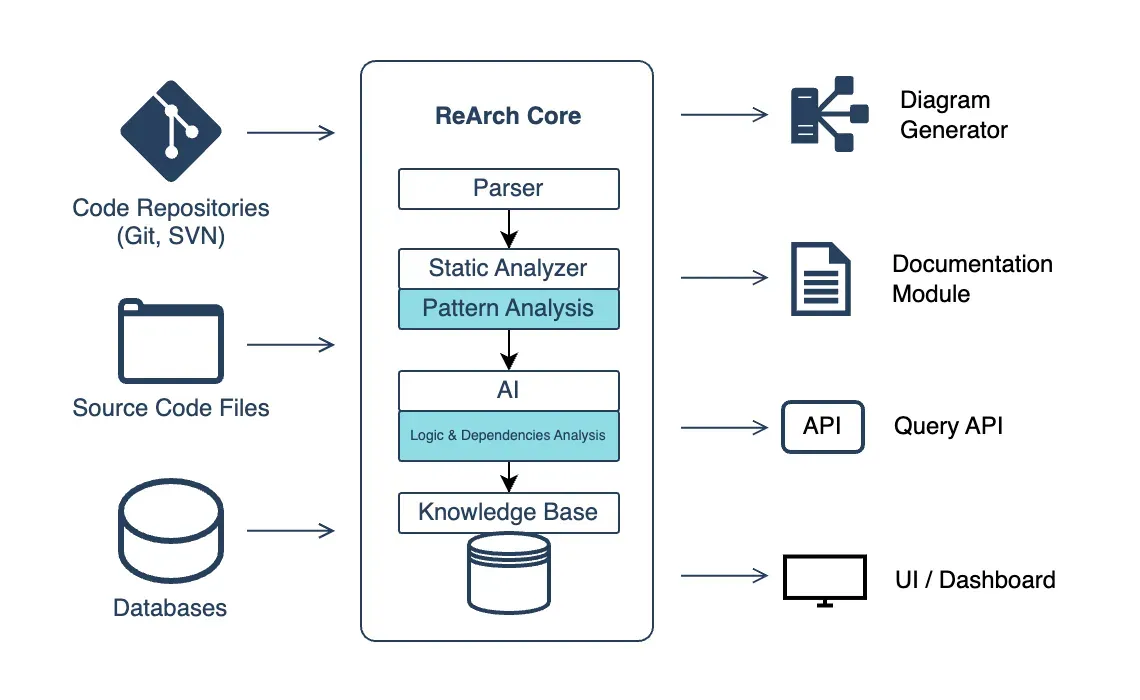Lab34 ReArch – AI and informed decisions in software rewriting and maintenance
Forensic code analysis and Artificial Intelligence to perform a autopsy and virtual reconstruction of software systems.

From “fear of change” to “informed decisions about change”.
ReArch is our internal tool that combines forensic code analysis techniques with the power of Artificial Intelligence to perform a detailed autopsy and virtual reconstruction of software systems. Its main goal is to transform source code, version histories, and potentially configuration or runtime data into a comprehensible and navigable knowledge model for decision-making and planning
ReArch: Illuminating the Black Box of Complex Software with Forensic Analysis and Artificial Intelligence
In the world of software development, complexity is often synonymous with opacity. Systems that have evolved over years, monolithic applications with intricate dependencies, or legacy code whose knowledge has been lost over time, become true black boxes. Operating, maintaining, and above all, evolving these critical systems becomes a titanic task, fraught with risks and uncertainties. At Lab34, we have developed ReArch, a forensic code analysis platform specifically designed to dissect these complexities and return control to technical and business teams.
The Fundamental Challenge: Understanding the Complex and the Forgotten
Working with mature or poorly documented software systems presents unique challenges:
Limited Visibility: How do components really interact? Where does key business logic reside? What are the hidden dependencies?
Inherent Risk of Change: Any modification, however small, can have unforeseen and catastrophic side effects. The fear of “breaking something” stifles innovation.
Operational Inefficiency: Onboarding new developers is slow and costly. Debugging errors becomes detective work. Planning improvements is, at best, a vague estimate.
Loss of Knowledge (“Tribal Knowledge”): Functional and technical understanding often resides in the memory of a few individuals, a huge risk for business continuity.
Obscure Technical Debt: Not only does technical debt exist, but its scope and location are often unknown, making it impossible to prioritize its resolution.
ReArch is born to address these challenges at their root, providing deep and actionable understanding of the internal reality of your software.
What Exactly is ReArch?
ReArch is an advanced platform that combines forensic code analysis techniques with the power of Artificial Intelligence to perform a detailed autopsy and virtual reconstruction of software systems. Its main goal is to transform source code, version histories, and potentially configuration or runtime data, into a comprehensible and navigable knowledge model.
It goes beyond traditional static analysis. ReArch is designed to:
Decipher Deep Structure: Identify components, modules, classes, functions and their interrelationships, even through layers of abstraction or intricate code.
Understand Software Problems:
Map Execution and Data Flows: Trace how information flows through the system and how key processes are executed.
Link Code with Functionality: Help understand which parts of the code implement specific business use cases.
Evaluate Operational Impact: Understand how technical features affect (or are critical to) the company’s daily operations.

Key ReArch Capabilities: A Detailed Look
ReArch offers an integrated set of tools to navigate complexity:
Structural Analysis and Advanced Visualization:
- Automatic Diagram Generation: ReArch creates accurate and up-to-date visual representations of the system, including:
- Component/Module Architecture Diagrams: For a high-level view.
- Dependency Diagrams: Showing interconnections between classes, modules, or services.
- Sequence or Call Flow Diagrams: To understand how specific processes are executed.
- (Optional) Data Flow Diagrams: Following critical information through the system.
- Automatic Diagram Generation: ReArch creates accurate and up-to-date visual representations of the system, including:
Deep Diagnosis of Code Quality and Health:
- Critical Point Identification: ReArch examines source code to automatically detect “code smells” (indicators of structural problems), excessive cyclomatic complexity, code duplication, and other characteristics that negatively impact maintainability and readability.
- Reliability Assessment: Analyzes code patterns known to be error-prone, identifying potential logic bugs or unhandled exceptions before they cause production problems.
- Best Practices Adherence Analysis: Verifies compliance with coding standards and robust design principles, helping maintain long-term software consistency and quality.
- Value: Provides an objective view of “Obscure Technical Debt,” allowing prioritization of refactoring efforts in areas of greatest risk or impact. Facilitates continuous improvement of the codebase and reduces future maintenance costs.
Security Risk Exposure Assessment:
- Vulnerable Pattern Detection: The platform incorporates analysis to identify coding patterns commonly associated with security vulnerabilities (such as injection points, insecure handling of sensitive data, weak configurations, etc.).
- Integrated Security Awareness: Helps teams visualize where potential security weak points reside within the architecture and code.
- Value: Enables proactive addressing of security risks as part of the development and maintenance lifecycle, contributing to system robustness and reliability against threats. Reduces the risk of costly security breaches.
- Forensic Analysis of Change Impact:
- Precise Simulation: Before writing a single line of code for a new feature or refactoring, ReArch allows selecting areas to modify (files, classes, functions).
- Exhaustive Identification: The tool traces all direct and indirect dependencies, identifying every part of the system (code, APIs, potentially configurations or even mapped business use cases) that will be affected by the proposed change.
- Value: Drastically reduces the risk of unexpected regressions. Enables more accurate effort estimates and more focused test planning. Transforms “fear of change” into “informed change.”
Intelligent Documentation Generation:
Key Knowledge Extraction: ReArch’s AI can analyze comments, variable/function names, and code structure to generate descriptive summaries of key modules or functionalities.
Documentation Site Generation.
- Planning and Assignment Support:
- Change Breakdown: Based on impact analysis, ReArch can help decompose large initiatives (e.g., refactoring a module, extracting a microservice) into smaller, manageable tasks.
- Necessary Resource Identification: Suggests not only what code to touch, but also what specific knowledge might be needed (e.g., database expert, UI specialist) or what additional technical resources are required (e.g., new library, message queue).
- Potential Integration: While ReArch is not a project management tool per se, it can export these tasks or integrate with existing systems (Jira, Azure DevOps) to facilitate assignment and tracking.
- Value: Connects deep technical analysis with practical execution planning, ensuring the right resources are assigned to the correct tasks with a clear understanding of scope.
Typical Use Cases for ReArch:
Legacy Modernization: Plan refactoring, re-architecture (e.g., Monolith to Microservices) or cloud migration with complete visibility.
Technical Due Diligence: Quickly assess the quality, complexity, and risks of a software asset during mergers and acquisitions.
Accelerated Onboarding: Enable new team members to quickly understand complex systems.
Quality and Maintainability Improvement: Identify critical areas to refactor, reduce technical debt, and improve test coverage.
Complex Problem Resolution: Diagnose elusive bugs or performance bottlenecks by tracing flows and dependencies.
Governance and Compliance: Ensure actual architecture aligns with defined standards and document systems for audits.
The ReArch Difference: Intelligence and Forensic Depth
While various code analysis tools exist, ReArch distinguishes itself by:
Forensic Approach: Goes beyond superficial metrics to uncover the “story” and real logic embedded in the code.
AI Integration: Uses AI not just to analyze, but to understand, generate explanations, and facilitate future action planning.
End-to-End Vision: Connects technical code with business use cases and operational impact.
Action Orientation: Not only informs, but enables safe and efficient planning and execution of changes.
Conclusion: From Opacity to Strategic Clarity
ReArch is not simply an analysis tool; it’s a software intelligence platform designed to return control over the most critical and complex systems. By providing deep understanding, clear visualizations, precise impact analysis, and planning support, ReArch enables organizations to make informed decisions, reduce risks, accelerate innovation, and maximize the value of their existing software assets.
Interested in a deeper exploration of ReArch and its capabilities?
- Contact our team of experts to discuss how ReArch can address your organization’s specific challenges.
It’s time to turn on the light inside your software. Discover what ReArch can reveal.